INDEX

Scene from the National Conference for Promoting Disaster Risk Reduction 2020 (held online on due to COVID-19), October 3, 2020
See the website. (http://bosai-kokutai.jp/)
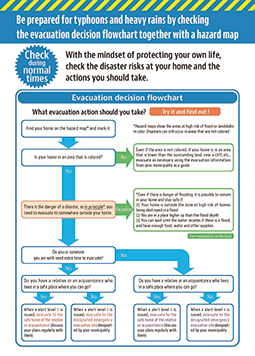
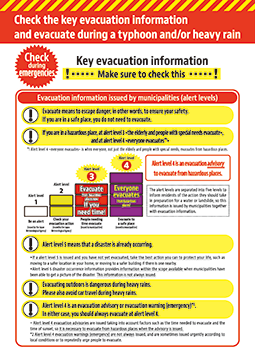
Municipal governments have distributed evacuation-related leaflets to households. The evacuation decision flowchart (top) helps each individual decide what actions to take, considering the risks faced in his/her home. The key evacuation information sheet (bottom) helps individuals understand alert levels and other evacuation information so as to decide when to evacuate. 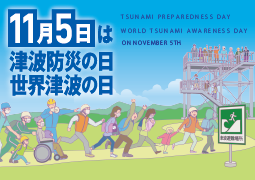
Publicity for the Tsunami Preparedness Day and World Tsunami Awareness Day. November 5th was chosen based on the true story of the present-day town of Hirogawa in Wakayama Prefecture. When a large earthquake in western Japan struck on November 5th, 1854, one resident in the town set fire to rice sheaves to lead others escaping in the dark to safe elevated land. 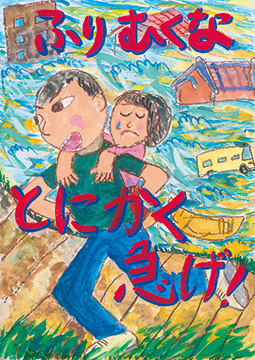
The painting that won the 2019 Disaster Management Poster Contest, Minister of State for Disaster Management Award in the division for sixth grade elementary school students and first year junior high school students. The text reads, “Don’t look back. Just hurry!” 
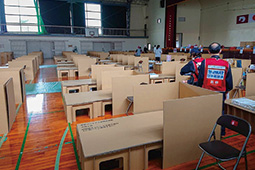
Evacuation shelters incorporating COVID-19 control measures. Cloth partitions and cardboard beds are placed apart from each other to ensure social distancing.
October 2020
Preparing for Disasters Together


Japan is prone to natural disasters, including earthquakes, tsunami, typhoons and floods. The national and local governments, citizens and all other stakeholders are collaborating in measures for disaster risk reduction and management.
Public awareness activity for raising the disaster consciousness of citizens by the Japanese Government
To increase people’s awareness of the need to protect their own lives, it is important to ensure on a regular basis that each individual recognizes their own disaster risks and understand what kind of actions should be taken in the case of emergency. To achieve this, the government led a Disaster Evacuation Awareness-raising Campaign throughout Japan in April and May 2020 in participation with many stakeholders. The campaign aimed to raise public awareness to encourage people to evacuate appropriately and in a timely manner in the event of a disaster.
National Conference for Promoting Disaster Risk Reduction

See the website. (http://bosai-kokutai.jp/)
Since 2016, the Japanese government has been holding an annual National Conference for Promoting Disaster Risk Reduction, one of the largest disaster preparedness events in Japan, in cooperation with local governments, private businesses and other entities that are working to prepare for disasters. The 5th National Conference for Promoting Disaster Risk Reduction was held on October 3, 2020. Due to novel coronavirus (COVID-19), the conference was held online. A total of 117 entities participated in the conference, including the national government, local governments, research institutions, private businesses, NPOs and other entities taking up the challenge of disaster risk reduction and management. The conference included a talk with the governors of Hiroshima and Mie Prefectures, discussions among disaster preparedness experts, and presentations on themes such as Disaster Risk Reduction Education and the use of advanced technology to reduce disaster risk.
Tsunami Preparedness Day


The tsunami that followed the Great East Japan Earthquake in March of 2011 took the lives of many people. In Japan, November 5th has been designated Tsunami Preparedness Day, to deepen understanding of and interest in tsunami countermeasures. In 2015, a United Nations resolution declared the day to be World Tsunami Awareness Day.
During the period before and after Tsunami Preparedness Day, events and evacuation training are held around the nation to raise people’s awareness and ability to take correct actions regarding tsunami preparedness.
Evacuation in the event of a disaster and COVID-19 control measures


If a disaster occurs while COVID-19 remains a concern, it is necessary to take measures to thoroughly control COVID-19, such as reducing the density of evacuees at evacuation shelters and securing adequate space. The government has advised local authorities regarding points that must be addressed regarding evacuation centers’ COVID-19 control measures, including the layout of the evacuation centers.
As for if or how to evacuate, people in hazardous places should evacuate in principle, even if COVID-19 has not subsided. However, those who are in a safe place do not need to go to an evacuation shelter, but should consider evacuating to a hotel or a relative’s or acquaintance’s home that is safe. The government has taken measures to raise residents’ disaster awareness, including the dissemination of leaflets in fourteen languages that describe five points to keep in mind during an evacuation.
See the multi-lingual leaflet. (http://www.bousai.go.jp/kokusai/evacuation_points/index_en.html)

